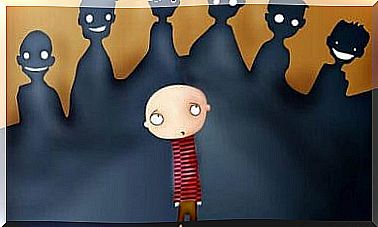Do You Know The Chameleon Effect?

In psychology, there is a wide variety of syndromes and effects. Many people use the metaphor in their name to refer to the explanation of the effect. We can for example name the Peter Pan syndrome, the Jerusalem syndrome, the Othello syndrome, the Benjamin Franklin effect, the Mandela effect, etc. If we had to highlight one, it would be the chameleon effect.
Chameleons are small, scaled reptiles with large, colorful eyes and stretchy tongues. They are very characteristic in the eyes of the general public for their ability to change their skin color. However, the popular conception that they change color for camouflage is not entirely accurate. Similarly, the chameleon effect does not indicate how people change color, but how they change.
Chameleons changing color
Only certain species of chameleons have the ability to change color. Chameleons are not colorless and their color changes do not always occur in harmony with the environment. The majority of color changes are due to a physiological condition. Chameleons respond to temperature and time of day by changing color.
The color also changes in other situations due to the presence of psychological factors. For example, facing an opponent or a partner. In fights between chameleons, the latter also change color. The color indicates whether the chameleon is angry or scared. The change of color is sometimes also a means of communication between chameleons.

People changing color
In a Woody Allen movie Zelig, a very strange character appears. Portrayed by Woody Allen himself, the main character Leonard Zelig appears in different places and interacts with different people. So far, everything is normal but Zelig presents a different aspect each time. When he is with black people, his skin color and voice change. When he meets Jews, his beard grows and English women appear in his hair. When he is in the company of heavier people, his weight also increases.
This strange case is studied by Doctor Eudora Flechter, played by Mia Farrow. The doctor manages to discover in Zelig an extreme case of insecurity which leads him to camouflage himself among people by adapting his appearance in order to be accepted. Zelig has the supernatural ability to change his appearance by adapting to the environment in which he evolves, thus giving him the name Chameleon Man. After lying about having read a book, Moby Dick, his need for acceptance to feel included leads him to transform physically and psychologically.

Obviously, Woody Allen’s film is a parody or attempts to be so by the search for the caricature. It shows an impossible situation which, faced with the metaphor, can lead to a better understanding of what the chameleon effect consists of. This effect is also called emotional contagion and is based on the tendency to feel and internalize emotions similar to those we see and in the same way, condition those of others. It is a process in which the person is influenced and at the same time exerts an influence on the emotions and behaviors of other people or other groups.
The chameleon effect
The chameleon effect defines a reality, that of the fact that in a certain way we all function as if we were a mirror to other people. We imitate the emotions of others or at least the emotions that we subconsciously think others are expressing. This effect does not stop there, we also imitate postures and facial expressions, language, tone, accent and vocabulary.
Our natural reaction when someone suffers from giggles is to laugh too. When we’re around people with a different accent, we usually don’t take long to get used to it. If we are sitting with someone crossing their legs, we may end up sitting the same way. Although this effect does not always occur, it appears very often, both in a conscious form and in an unconscious form.
Function of the chameleon effect
The function of the chameleon effect, from an evolutionary perspective, was sensed by Charles Darwin. The actions we take partly determine how we feel. Likewise, signals from other people will influence us. This allows personal well-being to be greater and it also allows us to integrate into groups. Without realizing it, little signals from others show us how to act and our mirror neurons allow us to imitate them.
We may all have a Zelig within us. When we are with other people, we adapt to have the same emotional state as them. Emotions are like a virus, they are transmitted to those around us. We are programmed to contaminate and be contaminated with emotions from birth. If you experience positive emotions, others will be able to feel them as well. If, on the contrary, you feel negative emotions, others will feel them the same way. While much of this process is subconscious, you can take the first step with your positive emotion.










